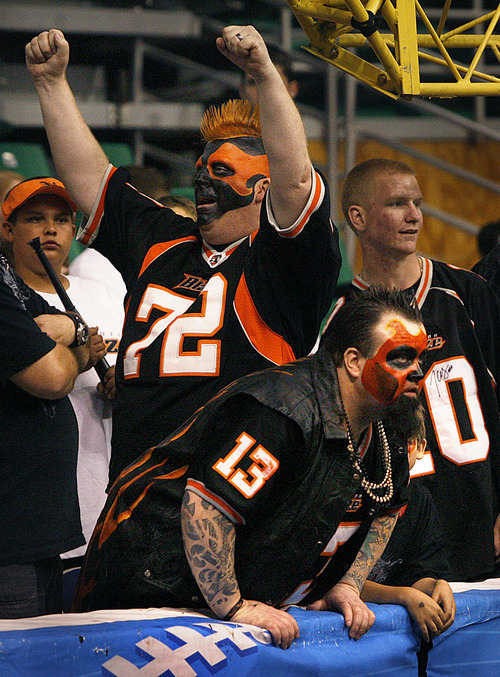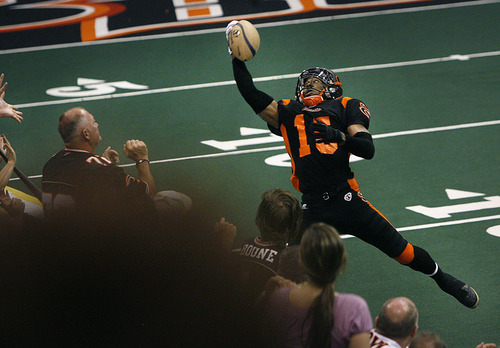This is an archived article that was published on sltrib.com in 2011, and information in the article may be outdated. It is provided only for personal research purposes and may not be reprinted.
During a time when lockouts are dominating sports headlines, the Utah Blaze are simply happy to be playing at all.
When the Arena Football League went dark in 2009, so did pro football in Utah. The Blaze, a generally healthy franchise during its three years in the league, was dropped by the Garff family and might not have been resurrected again if not for a few adventurous entrepreneurs.
Fast-forward to this summer, and Utah (7-7) is on the cusp of the playoffs. The franchise isn't exactly where it wants to be, but it's still afloat and its prospects are looking up. Majority owners Logan Hunter and Kristin Murdock are now comfortable enough to say the AFL should be here to stay.
"If we get back anywhere close to the attendance the team was getting in the first three years, we'll be just fine," Hunter says. "We've turned the corner for sure. I don't think we're in any jeopardy."
It has been a long road for two people who had never run a sports team before two years ago. Both Hunter and Murdock came in as minority owners with Dave Affleck, who owned an Orem-based arena team called the Utah Thunder that would eventually morph into the second coming of the Blaze.
For Hunter, a Subway franchisee who played wide receiver at BYU, it represented a chance to get hands-on involvement in football. For Murdock, who owns greeting card and cookie companies, it was something of an experiment.
"There were a lot of things I didn't realize about it," Murdock says. "I was curious about Arena Football, and it was interesting to me as a business person."
Setbacks came almost immediately. First, the new ownership couldn't solidify a deal to bring the team back to EnergySolutions Arena, and they eventually settled on playing at Maverik Center in West Valley City. Some fans followed the Blaze back, but many didn't. Worse yet, when the Blaze got on the field, they lost. A lot.
It was a frustrating experience for Hunter and Murdock, who were then minority owners caught mostly on the sidelines. They didn't like the coaching, the venue or a lot of the players they had. So last September, they bought Affleck out and took control.
The two hadn't even known each other before going in on the team together, but they quickly made progress.
For starters, the Blaze finally made a deal with ESA to return to their original home in January. Hunter and Murdock also gave coach Ron James, brought on late in the season as a replacement coach, the means to improve the team. They hired a director of player personnel and allowed James and his staff to operate freely, building the team in their own image.
"One of the reasons I took this job is because I got a vibe from Kristin and Logan that they were excited about the team but they had a sense that they had something still to learn," says James, who was a coordinator in the Blaze's previous incarnation. "It takes a strong ownership group to sit back and trust the people they've hired. It's a breath of fresh air compared to other owners I've been involved with over the years."
The return on the changes and the costs of building a better team are coming gradually. Utah is still in a crowded playoff field, but the team has a winning record at home. The Blaze have two of the league's most marketable players in quarterback Tommy Grady and Aaron Boone. And Murdock, who is the league's only female owner, does her best in the day-to-day operations to make players feel welcome by ensuring housing, health care and sometimes even meals are handled.
Attendance dipped a bit after the Blaze debuted at ESA, but it's ticked up to nearly 8,500 people per game, about a 69 percent improvement from the year at the Maverik Center. Discounted tickets and promotions, such as Military Night, have helped.
Although the league in general has less corporate sponsorship, a new financial model in which the AFL as an entity pays players and coaches instead of teams themselves has generated more stability. And the league is once again getting national television exposure through weekly games on the NFL Network.
Hunter and Murdock — who also brought in former BYU football star Jason Buck as a minority owner — hope that with another year of promotion and a playoff run, interest in the team will continue to grow. Jim Olson, Utah Jazz senior vice president of sales and marketing, says there are no regrets to bringing the Blaze back.
"We are pleased with the Blaze and the numbers coming in," he says. "The team is having good success on the field, and as people become more aware, time will allow it to grow."
There's still a lot of room to make up, especially in the upper bowl. At its height under the Garffs, the Blaze attracted an average of 14,000 fans per game — a rollicking crowd for the AFL. Other potential league issues, such as low player and coach salaries, could be storm clouds ahead.
But James, one of the few holdovers from the old Blaze, sees the pieces slowly coming together.
"With the new model, it's a totally different animal, but there's some small steps back to that level," he says. "We're getting our feet wet, and people know we're here. Once the crowd comes in, the sponsors will recognize the value of what we're doing."
kgoon@sltrib.com Twitter: @kylegoon —
Arena League attendance
Team Avg.
1. Orlando 11,943
2. Tampa Bay 10,758
3. Spokane 9,512
4. San Jose 9,492
5. Pittsburgh 9,271
6. Jacksonville 9,062
7. Arizona 8,909
8. Philadelphia 8,861
9. Iowa 8,738
10. Chicago 8,617
11. Utah 8,466
12. New Orleans 8,002
13. Dallas 7,215
14. Cleveland 6,319
15. Tulsa 5,504
16. Kansas City 4,138
17. Georgia 4,025
18. Milwaukee 3,553
Source: ArenaFan, official fan site of the Arena Football League —
Blaze at Chicago
P Friday
6:30 p.m.







